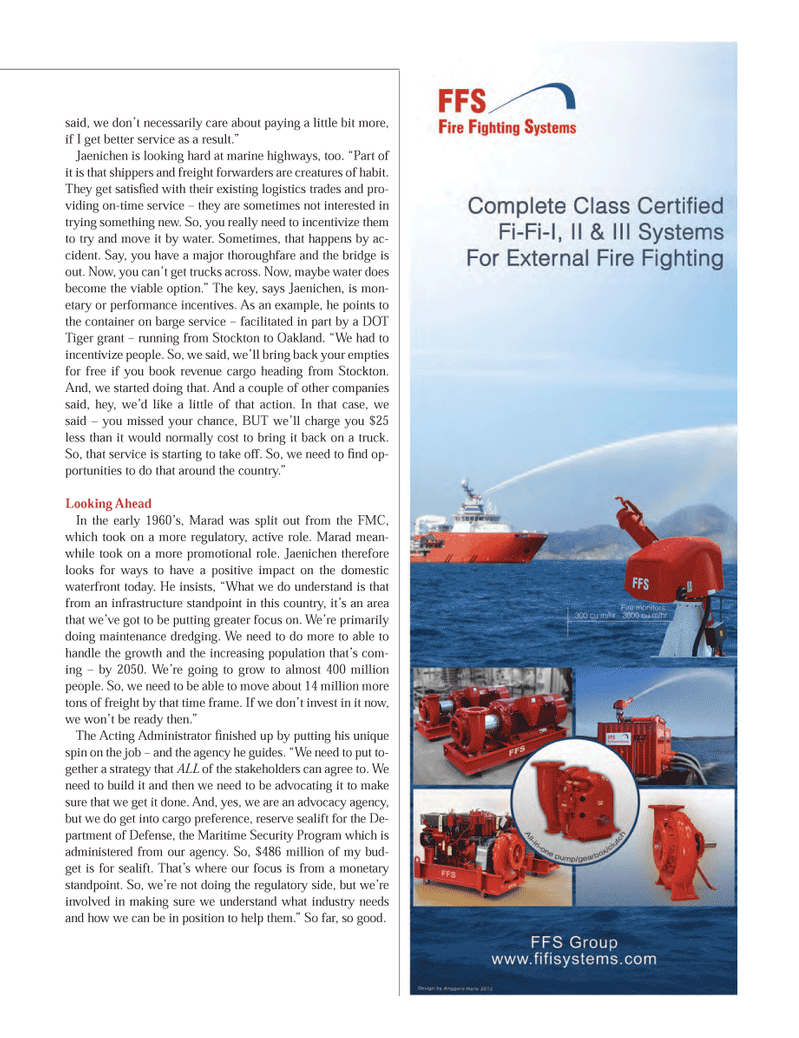
Page 21: of Maritime Logistics Professional Magazine (Q2 2014)
Maritime Risk & Shipping Finance
Read this page in Pdf, Flash or Html5 edition of Q2 2014 Maritime Logistics Professional Magazine
said, we don’t necessarily care about paying a little bit more, if I get better service as a result.”
Jaenichen is looking hard at marine highways, too. “Part of it is that shippers and freight forwarders are creatures of habit.
They get satisfi ed with their existing logistics trades and pro- viding on-time service – they are sometimes not interested in trying something new. So, you really need to incentivize them to try and move it by water. Sometimes, that happens by ac- cident. Say, you have a major thoroughfare and the bridge is out. Now, you can’t get trucks across. Now, maybe water does become the viable option.” The key, says Jaenichen, is mon- etary or performance incentives. As an example, he points to the container on barge service – facilitated in part by a DOT
Tiger grant – running from Stockton to Oakland. “We had to incentivize people. So, we said, we’ll bring back your empties for free if you book revenue cargo heading from Stockton.
And, we started doing that. And a couple of other companies said, hey, we’d like a little of that action. In that case, we said – you missed your chance, BUT we’ll charge you $25 less than it would normally cost to bring it back on a truck.
So, that service is starting to take off. So, we need to fi nd op- portunities to do that around the country.”
Looking Ahead
In the early 1960’s, Marad was split out from the FMC, which took on a more regulatory, active role. Marad mean- while took on a more promotional role. Jaenichen therefore looks for ways to have a positive impact on the domestic waterfront today. He insists, “What we do understand is that from an infrastructure standpoint in this country, it’s an area that we’ve got to be putting greater focus on. We’re primarily doing maintenance dredging. We need to do more to able to handle the growth and the increasing population that’s com- ing – by 2050. We’re going to grow to almost 400 million people. So, we need to be able to move about 14 million more tons of freight by that time frame. If we don’t invest in it now, we won’t be ready then.”
The Acting Administrator fi nished up by putting his unique spin on the job – and the agency he guides. “We need to put to- gether a strategy that ALL of the stakeholders can agree to. We need to build it and then we need to be advocating it to make sure that we get it done. And, yes, we are an advocacy agency, but we do get into cargo preference, reserve sealift for the De- partment of Defense, the Maritime Security Program which is administered from our agency. So, $486 million of my bud- get is for sealift. That’s where our focus is from a monetary standpoint. So, we’re not doing the regulatory side, but we’re involved in making sure we understand what industry needs and how we can be in position to help them.” So far, so good. 18-33 Q2 MP2014.indd 21 5/16/2014 2:50:35 PM

 20
20

 22
22
